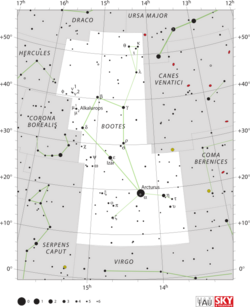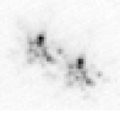Astronomy:Zeta Boötis
| Observation data Equinox J2000.0]] (ICRS) | |
|---|---|
| Constellation | Boötes |
| Right ascension | 14h 41m 08.95158s[1] |
| Declination | +13° 43′ 41.8967″[1] |
| Apparent magnitude (V) | 3.78[2](4.46 + 4.55)[3] |
| Characteristics | |
| Spectral type | A2III + A2III[4] A1V[5] |
| U−B color index | +0.05[2] |
| B−V color index | +0.05[2] |
| Astrometry | |
| Radial velocity (Rv) | −8.5±0.6[6] km/s |
| Proper motion (μ) | RA: +51.95[1] mas/yr Dec.: -11.08[1] mas/yr |
| Parallax (π) | 18.07 ± 1.24[1] mas |
| Distance | 180 ± 10 ly (55 ± 4 pc) |
| Absolute magnitude (MV) | +0.13[7] |
| Orbit[8] | |
| Companion | B |
| Period (P) | 45,460±62 d |
| Semi-major axis (a) | 2.3±1.7″ |
| Eccentricity (e) | 0.9977±0.0034 |
| Inclination (i) | 102.3±9.2° |
| Longitude of the node (Ω) | 8.2±2.6° |
| Periastron epoch (T) | 2,460,183.5±57 JD |
| Argument of periastron (ω) (secondary) | 262.9±5.9° |
| Details | |
| Luminosity | 81[7] L☉ |
| Other designations | |
| A: HD 129247, HR 5478[10] | |
| B: HD 129246, HR 5477[11] | |
| Database references | |
| SIMBAD | data |
Zeta Boötis, Latinized from ζ Boötis, is a binary star system in the constellation of Boötes. They have the Flamsteed designation 30 Boötis; Zeta Boötis is the Bayer designation. This system is visible to the naked eye with a combined apparent magnitude of +3.78.[2] The individual magnitudes differ slightly, with component A having a magnitude of 4.46 and component B at the slightly dimmer magnitude 4.55.[3] It is located at a distance of approximately 180 light years from the Sun based on parallax,[1] but is drifting closer with a radial velocity of −9 km/s.[6]
The duplicity of this star was discovered by English astronomer William Herschel in 1796, and their changing positions have been tracked from 1823 onward.[12] They complete an orbit roughly every 124.5 years (45,460 days). The orbit of this pair has a very high eccentricity of 0.9977, bringing the stars within 0.3 AU at their closest approach. The next close approach will occur during August 2023.[8]
In 1976, T. W. Edwards found a stellar classification of A2III for both components, suggesting they may be evolved A-type giant stars. Helmut A. Abt reported a class of A2V in 1981, which matches an A-type main-sequence star.[13] Abt and Nidia Morrell updated the classification to A1V in 1995.[5] Considering the extreme nature of their orbit, it is unlikely that any companion exoplanets could have stable orbits around either star.[14]
Gallery
Zeta Bootis imaged with the Nordic Optical Telescope on 13 May 2000 using the lucky imaging method. (The Airy discs around the stars is diffraction from the 2.56m telescope aperture.)
Typical short-exposure image of a binary star, as seen using speckle imaging through the Earth's atmosphere.
References
- ↑ 1.0 1.1 1.2 1.3 1.4 1.5 van Leeuwen, F. (November 2007), "Validation of the new Hipparcos reduction", Astronomy and Astrophysics 474 (2): 653–664, doi:10.1051/0004-6361:20078357, Bibcode: 2007A&A...474..653V
- ↑ 2.0 2.1 2.2 2.3 Nicolet, B. (1978), "Photoelectric photometric Catalogue of homogeneous measurements in the UBV System", Astronomy and Astrophysics Supplement Series 34: 1–49, Bibcode: 1978A&AS...34....1N.
- ↑ 3.0 3.1 Mason, B. D. et al. (2014), "The Washington Visual Double Star Catalog", The Astronomical Journal 122 (6): 3466–3471, doi:10.1086/323920, Bibcode: 2001AJ....122.3466M.
- ↑ Edwards, T. W. (April 1976), "MK classification for visual binary components", Astronomical Journal 81: 245–249, doi:10.1086/111879, Bibcode: 1976AJ.....81..245E.
- ↑ 5.0 5.1 Abt, Helmut A.; Morrell, Nidia I. (July 1995), "The Relation between Rotational Velocities and Spectral Peculiarities among A-Type Stars", Astrophysical Journal Supplement 99: 135, doi:10.1086/192182, Bibcode: 1995ApJS...99..135A.
- ↑ 6.0 6.1 Gontcharov, G. A. (2006), "Pulkovo Compilation of Radial Velocities for 35 495 Hipparcos stars in a common system", Astronomy Letters 32 (11): 759–771, doi:10.1134/S1063773706110065, Bibcode: 2006AstL...32..759G.
- ↑ 7.0 7.1 Anderson, E.; Francis, Ch. (2012), "XHIP: An extended hipparcos compilation", Astronomy Letters 38 (5): 331, doi:10.1134/S1063773712050015, Bibcode: 2012AstL...38..331A.
- ↑ 8.0 8.1 Muterspaugh, Matthew W. et al. (December 2010), "The Phases Differential Astrometry Data Archive. II. Updated Binary Star Orbits and a Long Period Eclipsing Binary", The Astronomical Journal 140 (6): 1623–1630, doi:10.1088/0004-6256/140/6/1623, Bibcode: 2010AJ....140.1623M.
- ↑ "zet Boo". SIMBAD. Centre de données astronomiques de Strasbourg. http://simbad.u-strasbg.fr/simbad/sim-basic?Ident=zet+Boo.
- ↑ "zet Boo A". SIMBAD. Centre de données astronomiques de Strasbourg. http://simbad.u-strasbg.fr/simbad/sim-basic?Ident=zet+Boo+A.
- ↑ "zet Boo B". SIMBAD. Centre de données astronomiques de Strasbourg. http://simbad.u-strasbg.fr/simbad/sim-basic?Ident=zet+Boo+B.
- ↑ Wierzbiński, St. (1956), "Orbites des étoiles doubles", Acta Astronomica 6: 82, Bibcode: 1956AcA.....6...82W.
- ↑ Abt, H. A. (1981), "Visual multiples. VII. MK classifications", The Astrophysical Journal Supplement Series 45: 437, doi:10.1086/190719, Bibcode: 1981ApJS...45..437A.
- ↑ Muterspaugh, Matthew W. et al. (December 2010), "The Phases Differential Astrometry Data Archive. III. Limits to Tertiary Companions", The Astronomical Journal 140 (6): 1631–1645, doi:10.1088/0004-6256/140/6/1631, Bibcode: 2010AJ....140.1631M.
External links
- Kaler, James B., "ZETA BOO (Zeta Bootis)", Stars (University of Illinois), http://stars.astro.illinois.edu/sow/zetaboo.html, retrieved 2011-12-18
- HR 5477
- Image Zeta Boötis
- CCDM J14411+1344
 |




